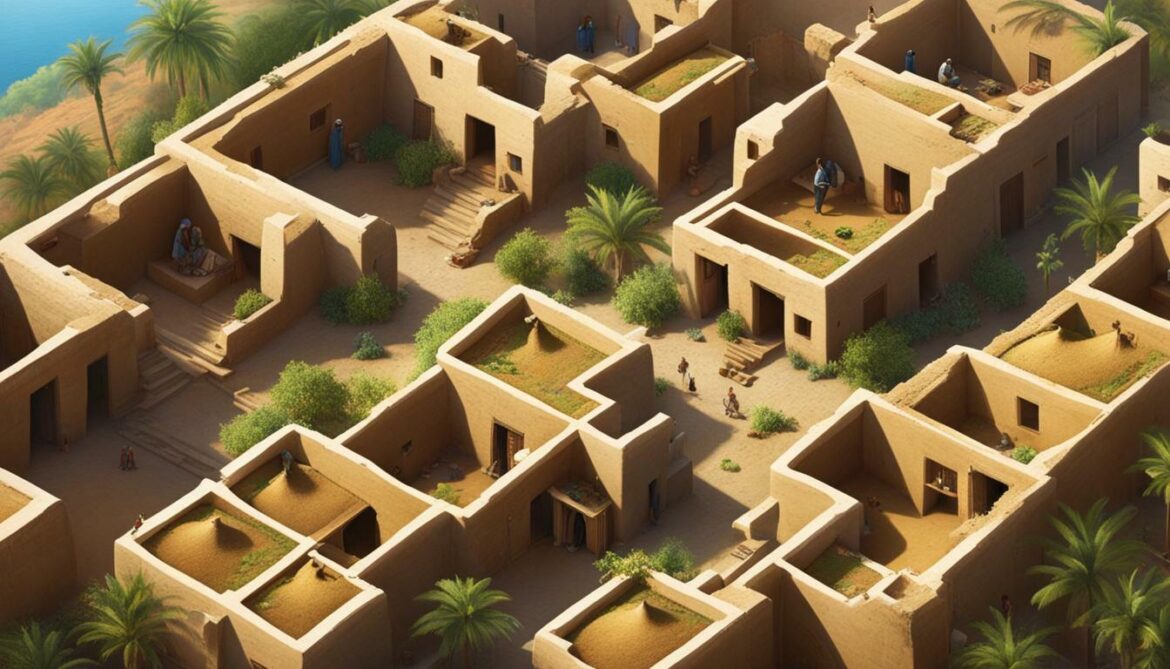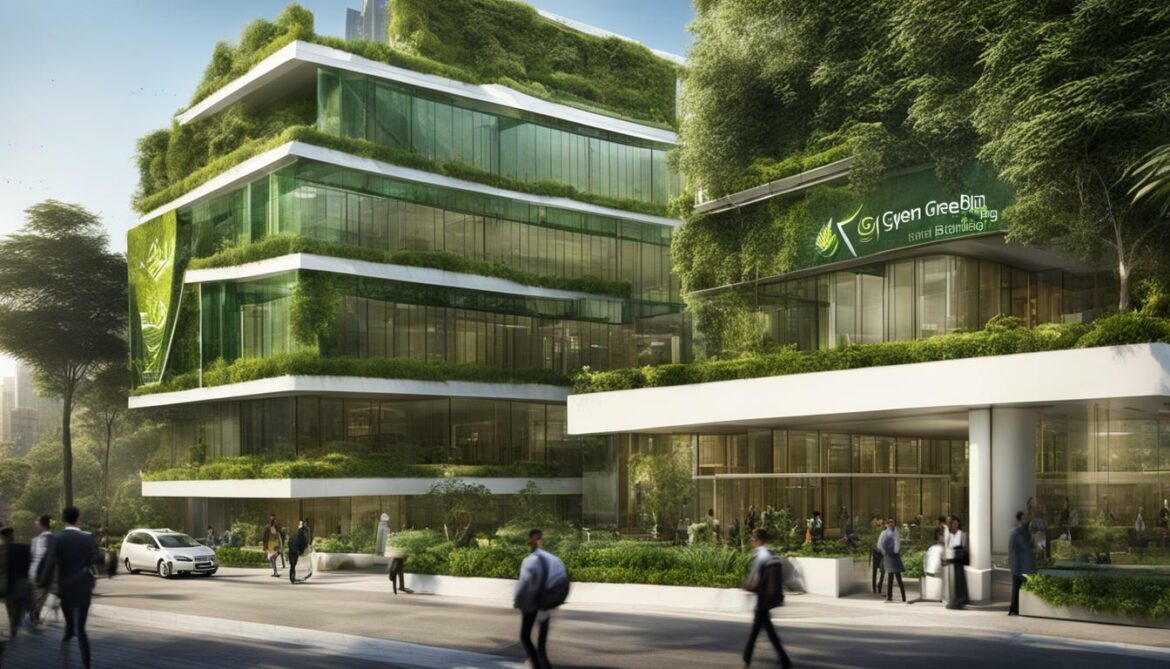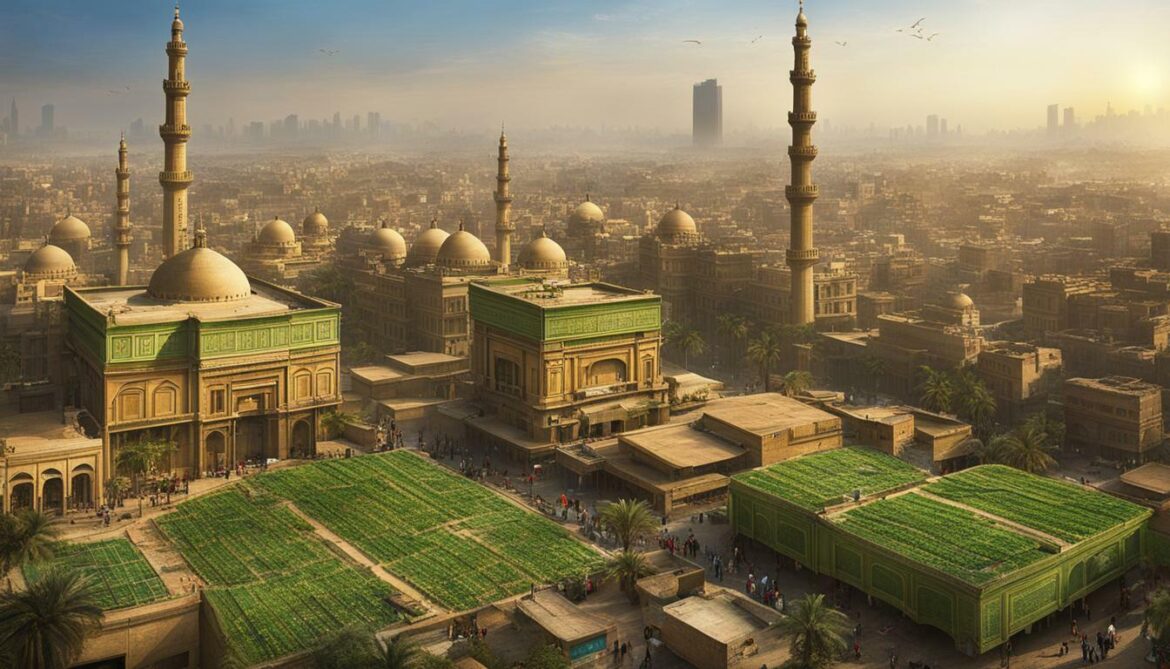Egypt has a rich history of sustainable architecture and ecological buildings, making it a leader in green building practices. From ancient times to the present day, the country has embraced the concept of green architecture as part of its commitment to sustainable development. Green buildings in Egypt are designed to minimize environmental impact, enhance energy efficiency, and create healthier living environments.
The Egyptian government has taken significant steps to promote sustainable architecture. The Green Architecture Initiative, launched by the government, focuses on integrating green building practices in low-income housing units. This initiative aims to provide environmentally friendly housing options while stimulating opportunities for the private sector. To evaluate and recognize the environmental credentials of buildings, the Green Pyramid Rating System (GPRS) has been introduced. This system assesses factors like energy and water efficiency to determine a building’s sustainability.
Green buildings in Egypt have demonstrated numerous benefits. They contribute to reduced energy consumption, carbon emissions, water usage, and solid waste. The Ministry of Housing is actively constructing green buildings in new cities such as the New Administrative Capital and New Alamein. These buildings incorporate state-of-the-art technologies to ensure sustainability and efficiency.
To further promote green architecture, legislation and incentives are crucial. Revisions to climate change and environment laws, as well as tax incentives, can encourage more construction companies to adopt green practices. The recognition of the Grand Egyptian Museum (GEM) as a green building exemplifies Egypt’s commitment to sustainability. The GEM has achieved the Gold Certificate for Green Building and Sustainability, implementing strategies for efficient water and energy conservation, along with the use of renewable energy sources.
The establishment of the Egypt Green Building Council (Egypt GBC) in 2012 has played a vital role in promoting sustainable building practices in the country. Egypt GBC aims to become a member of the World Green Building Council and has developed local rating systems like TARSHEED, tailored to the Egyptian ecosystem and materials.
Key Takeaways:
- Egypt has a rich history of sustainable architecture and ecological buildings.
- The Green Architecture Initiative focuses on integrating green building practices in low-income housing units.
- The Green Pyramid Rating System (GPRS) evaluates the environmental credentials of buildings based on factors such as energy and water efficiency.
- Green buildings in Egypt contribute to reduced energy consumption, carbon emissions, water usage, and solid waste.
- The Grand Egyptian Museum (GEM) has achieved the Gold Certificate for Green Building and Sustainability.
- The Egypt Green Building Council (Egypt GBC) promotes sustainable building practices and aims to become a member of the World Green Building Council.
Ancient Sustainable Practices in Egyptian Architecture
Ancient Egypt was known for its innovative sustainable practices in architecture, incorporating eco-friendly design elements that continue to inspire modern-day construction. The ancient Egyptians understood the importance of building structures that were not only functional but also harmonious with the natural environment.
“The ancient Egyptians were masters at utilizing sustainable materials and techniques,” says Dr. Amira Khattab, an expert in Egyptian architecture.
“One of their remarkable achievements was the construction of the pyramids, which utilized locally sourced limestone and were designed to withstand the test of time. The pyramids’ angled sides were not only aesthetically pleasing but also helped to distribute weight and reduce stress on the structure. The Egyptians also incorporated passive cooling techniques, such as strategic positioning of windows and ventilation shafts, to ensure comfortable living conditions even in the scorching desert heat.”
The ancient Egyptians also prioritized water conservation and management. They built intricate systems, such as canals and reservoirs, to capture and store water for agricultural purposes. Additionally, the use of mud bricks, made from locally available materials like clay and sand, reduced the environmental impact of construction.
| Key Sustainable Practices in Egyptian Architecture |
Impact |
| Incorporation of natural lighting and ventilation |
Reduced energy consumption |
| Utilization of locally sourced and sustainable materials |
Reduced environmental impact |
| Intelligent water management systems |
Efficient use of water resources |
| Passive cooling techniques |
Comfortable indoor conditions |
These ancient sustainable practices serve as a blueprint for modern-day architects and engineers, who strive to create environmentally friendly and energy-efficient buildings in Egypt and beyond. By drawing inspiration from the past, Egypt continues to pave the way towards a greener future.

- “Ancient Egyptian Architecture: Sustainable Design Principles” by Dr. Amira Khattab
- “Sustainability in Ancient Egypt” by The Archaeological Institute of America
Egypt’s Modern Green Building Initiatives
Egypt has made significant strides in modern green building initiatives, focusing on sustainable urban planning and incorporating sustainability in ancient Egyptian structures. As part of its efforts towards sustainable development, the country has embraced the concept of green architecture and building. Green buildings are designed to reduce environmental damage, improve energy efficiency, and create a healthier living environment.
The Egyptian government has launched the Green Architecture Initiative, which prioritizes green building in low-income housing units. This initiative aims to create environmentally friendly housing and stimulate opportunities for the private sector. To evaluate the environmental credentials of buildings, the Green Pyramid Rating System (GPRS) has been developed. The GPRS assesses measures such as energy and water efficiency, helping to promote the adoption of green building practices.
The Ministry of Housing is constructing green buildings in new cities like the New Administrative Capital and New Alamein. These buildings incorporate state-of-the-art technologies for sustainability, further advancing Egypt’s commitment to green architecture. However, legislation and incentives are needed to further promote green building practices. Revisions to climate change and environment laws, tax incentives, and incentives for green practices in construction companies can help create a more sustainable building sector in Egypt.
| Benefits of Green Buildings in Egypt |
Challenges of Green Buildings in Egypt |
- Reduced energy consumption
- Decreased carbon emissions
- Water usage efficiency
- Solid waste reduction
|
- Implementation challenges
- Cost considerations
- Limited awareness and expertise
- Resistance to change
|
“Green buildings in Egypt are key to achieving sustainable development goals and reducing the environmental impact of the building sector. They play a crucial role in conserving resources and creating healthier spaces for the population.”
Sustainability in Ancient Egyptian Structures
The rich history of ancient Egyptian architecture also contributes to modern green building initiatives in Egypt. The sustainable practices employed in ancient Egyptian structures, such as natural ventilation systems, strategic orientation for optimal sunlight, and the use of locally sourced materials, provide inspiration for sustainable design today. By incorporating these ancient principles, modern architects and engineers are able to create buildings that merge historical sustainability with contemporary technologies.
Green Building Materials in Egyptian History
Green building materials have played a crucial role in Egyptian history, with sustainable materials being used in construction for centuries. Ancient Egyptians were known for their innovative use of locally available resources, incorporating natural materials like mud bricks, limestone, and wood in their structures. These materials not only provided durability but also allowed for efficient resource utilization, minimizing environmental impact and fostering sustainable practices.
“The use of mud bricks in ancient Egyptian architecture is a remarkable example of sustainable construction,” says Dr. Ahmed Hassan, an expert in Egyptian architectural history.
“Mud bricks were made from locally sourced clay and straw, reducing the need for transporting materials over long distances. This not only saved energy but also promoted the use of renewable resources.”
The mud bricks offered thermal insulation, keeping interiors cool in the hot Egyptian climate. Moreover, these bricks could be recycled or repurposed after the demolition of buildings, further minimizing waste and contributing to a circular economy.
Another sustainable material used by ancient Egyptians was limestone. Known for its durability, limestone was extensively used in the construction of temples, tombs, and monuments. The sourcing of limestone from nearby quarries reduced transportation energy requirements, and its longevity ensured minimal replacement or maintenance needs over time.
Wood was also a valuable resource used by ancient Egyptians, particularly in furniture and decorative elements. The use of locally sourced wood from trees like sycamore and acacia demonstrated a commitment to sustainable forestry practices. Additionally, wood was often sourced from fallen or dead trees, ensuring minimal impacts on live ecosystems. Through these practices, ancient Egyptians set a precedent for sustainable construction, emphasizing the importance of utilizing environmentally friendly materials.
| Green Building Materials |
Advantages |
| Mud Bricks |
- Locally sourced
- Energy-efficient production
- Thermal insulation properties
- Promotes circular economy
|
| Limestone |
- Durable and long-lasting
- Reduced transportation energy requirements
- Low maintenance needs
|
| Wood |
- Locally sourced
- Utilization of fallen or dead trees
- Renewable and sustainable resource
|
Today, Egypt continues to embrace sustainable building practices, incorporating modern green building materials that align with its rich historical heritage. The use of eco-friendly materials in construction not only supports environmental conservation but also creates healthier and more energy-efficient spaces for the population to thrive in.
Government Support and Initiatives for Green Buildings
The Egyptian government has taken proactive measures to support green buildings, with initiatives by the Ministry of Housing and the establishment of the Egypt Green Building Council. These efforts reflect Egypt’s dedication to incorporating sustainability in its building sector and achieving its goals of sustainable development.
The Ministry of Housing has been at the forefront of promoting green buildings in Egypt. It has been actively constructing sustainable buildings in new cities like the New Administrative Capital and New Alamein. These cities are designed to be eco-friendly and integrate state-of-the-art technologies for sustainability.
To further promote green architecture, revisions to climate change and environment laws are being considered. The government is also exploring tax incentives and incentives for green practices in construction companies. These legislative and incentive measures aim to create a conducive environment for the growth of green buildings in Egypt.
Egypt Green Building Council (Egypt GBC)
The Egypt Green Building Council (Egypt GBC) was established in 2012 to promote sustainable building practices in the country. It is a member of the World Green Building Council and plays a crucial role in driving the adoption of green building standards in Egypt.
The Egypt GBC has developed local rating systems, such as TARSHEED, which tailor green building standards to the Egyptian ecosystem and materials. These rating systems enable the evaluation and certification of buildings based on their environmental performance, energy efficiency, and sustainable design.
| Initiatives for Green Buildings |
Government Entity |
| Green Architecture Initiative |
Ministry of Housing |
| Green Pyramid Rating System (GPRS) |
Ministry of Housing |
| Grand Egyptian Museum (GEM) |
Ministry of Tourism and Antiquities |
“The establishment of the Egypt Green Building Council and the implementation of green building initiatives by the Ministry of Housing demonstrate Egypt’s commitment to sustainable development and environmental stewardship.” – Ahmed El-Dorghamy, CEO of the Egypt Green Building Council
The Egypt GBC is also involved in capacity-building programs, workshops, and awareness campaigns to educate professionals and the public about the benefits of green buildings. These efforts contribute to building a more sustainable future for Egypt’s built environment.

Benefits and Challenges of Green Buildings in Egypt
Green buildings in Egypt have shown significant benefits, including reduced energy consumption, lower carbon emissions, efficient water usage, and sustainable waste management practices. These environmentally friendly buildings utilize innovative technologies and design principles to minimize their impact on the environment while creating healthier and more comfortable living spaces.
One of the key benefits of green buildings is their ability to reduce energy consumption. By incorporating energy-efficient systems and materials, these buildings can significantly decrease the amount of energy needed for heating, cooling, and lighting. This not only reduces carbon emissions but also helps homeowners and occupants save on utility bills.
Efficient water usage is another important aspect of green buildings. Through the use of water-saving fixtures, rainwater harvesting systems, and advanced irrigation techniques, these buildings can minimize water wastage and promote sustainable water management. This is particularly crucial in arid regions like Egypt, where water scarcity is a pressing issue.
Sustainable waste management practices are also integral to green buildings. By implementing recycling programs, composting facilities, and efficient waste disposal systems, these buildings can minimize the amount of solid waste produced and promote a circular economy. This not only reduces the strain on landfills but also contributes to the conservation of resources and the reduction of pollution.
Despite these benefits, green buildings in Egypt still face several challenges. The upfront costs of implementing green building technologies and materials can be higher compared to conventional construction methods, making it a barrier for some developers and homeowners. Additionally, there is a lack of awareness and understanding of green building practices among the general public, which can hinder the widespread adoption of sustainable design and construction.
To overcome these challenges, it is crucial for the Egyptian government to provide incentives and support for green building initiatives. This can include tax incentives, grants, and subsidies for sustainable construction. Furthermore, education and awareness programs should be implemented to promote the benefits of green buildings and encourage a shift towards more environmentally friendly practices.
| Benefits |
Challenges |
| Reduced energy consumption |
Higher upfront costs |
| Lower carbon emissions |
Lack of awareness and understanding |
| Efficient water usage |
|
| Sustainable waste management |
|
“Green buildings are not just a trend, but a necessity for a sustainable future. By embracing green building practices, Egypt can minimize its environmental impact, conserve resources, and improve the quality of life for its citizens.”
Summary
Green buildings in Egypt bring numerous benefits, including reduced energy consumption, lower carbon emissions, efficient water usage, and sustainable waste management. However, to fully realize the potential of green building practices, the country must address challenges such as upfront costs and lack of awareness. By providing incentives and promoting education, Egypt can build a more sustainable future.

Egypt’s rich green building history, combined with its commitment to sustainability, highlights the country’s dedication to incorporating sustainable practices in its building sector. As part of its efforts towards sustainable development, Egypt has embraced the concept of green architecture and building. Green buildings are designed to reduce environmental damage, improve energy efficiency, and create a healthier living environment.
The Egyptian government has launched the Green Architecture Initiative, which prioritizes green building in low-income housing units. This initiative aims to create environmentally friendly housing while stimulating opportunities for the private sector. To evaluate the environmental credentials of buildings, the Green Pyramid Rating System (GPRS) has been developed, focusing on measures such as energy and water efficiency.
Green buildings in Egypt have shown significant benefits, including a reduction in energy consumption, carbon emissions, water usage, and solid waste. The Ministry of Housing is constructing green buildings in new cities like the New Administrative Capital and New Alamein, integrating state-of-the-art technologies for sustainability. However, legislation and incentives are needed to further promote green architecture, including revisions to climate change and environment laws, tax incentives, and incentives for green practices in construction companies.
The Grand Egyptian Museum (GEM) stands as a shining example of Egypt’s commitment to green architecture. It has achieved the Gold Certificate for Green Building and Sustainability, incorporating environmentally friendly strategies, efficient water and energy conservation, and the use of renewable energy sources. Egypt’s dedication to green architecture aligns with its goals of sustainable development and hosting the COP27 climate summit.
The Egypt Green Building Council (Egypt GBC), established in 2012, plays a pivotal role in promoting sustainable building practices in the country. As a member of the World Green Building Council, the Egypt GBC has developed local rating systems like TARSHEED to tailor green building standards to the Egyptian ecosystem and materials. These efforts reflect Egypt’s dedication to incorporating sustainability in its building sector and paving the way for a greener future.
FAQ
What is green architecture?
Green architecture is a design concept that focuses on reducing environmental damage, improving energy efficiency, and creating a healthier living environment through sustainable building practices.
What is the Green Architecture Initiative in Egypt?
The Green Architecture Initiative in Egypt is a government-led program that prioritizes green building in low-income housing units, aiming to create environmentally friendly housing and stimulate opportunities for the private sector.
What is the Green Pyramid Rating System (GPRS)?
The Green Pyramid Rating System (GPRS) is a system developed in Egypt to evaluate the environmental credentials of buildings based on measures such as energy and water efficiency.
What are the benefits of green buildings in Egypt?
Green buildings in Egypt have shown significant benefits, including reduced energy consumption, carbon emissions, water usage, and solid waste.
What efforts has the Ministry of Housing made towards green architecture in Egypt?
The Ministry of Housing in Egypt is constructing green buildings in new cities like the New Administrative Capital and New Alamein, integrating state-of-the-art technologies for sustainability.
What is the role of legislation and incentives in promoting green architecture in Egypt?
Legislation and incentives are needed to further promote green architecture in Egypt, including revisions to climate change and environment laws, tax incentives, and incentives for green practices in construction companies.
Has any building in Egypt been recognized as a green building?
Yes, the Grand Egyptian Museum (GEM) has been recognized as a green building, achieving the Gold Certificate for Green Building and Sustainability. It incorporates environmentally friendly strategies, efficient water and energy conservation, and the use of renewable energy sources.
What is the Egypt Green Building Council (Egypt GBC)?
The Egypt Green Building Council (Egypt GBC) was established in 2012 to promote sustainable building practices in the country and become a member of the World Green Building Council.
How does Egypt tailor green building standards to its ecosystem?
The Egypt Green Building Council has developed local rating systems, such as TARSHEED, to tailor green building standards to the Egyptian ecosystem and materials.
What does Egypt’s commitment to green architecture align with?
Egypt’s commitment to green architecture aligns with its goals of sustainable development and hosting the COP27 climate summit.
Source Links





















Post comments (0)